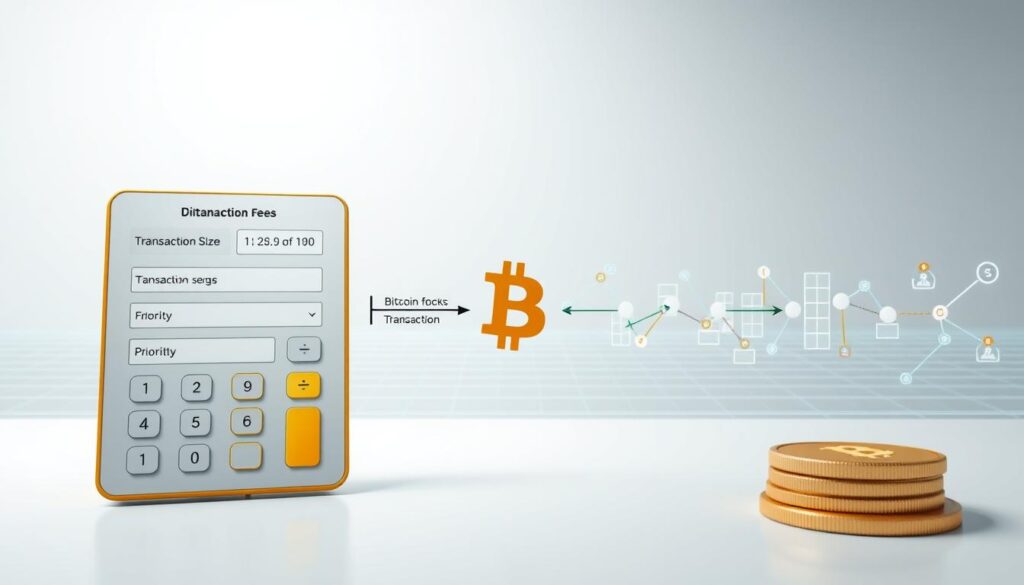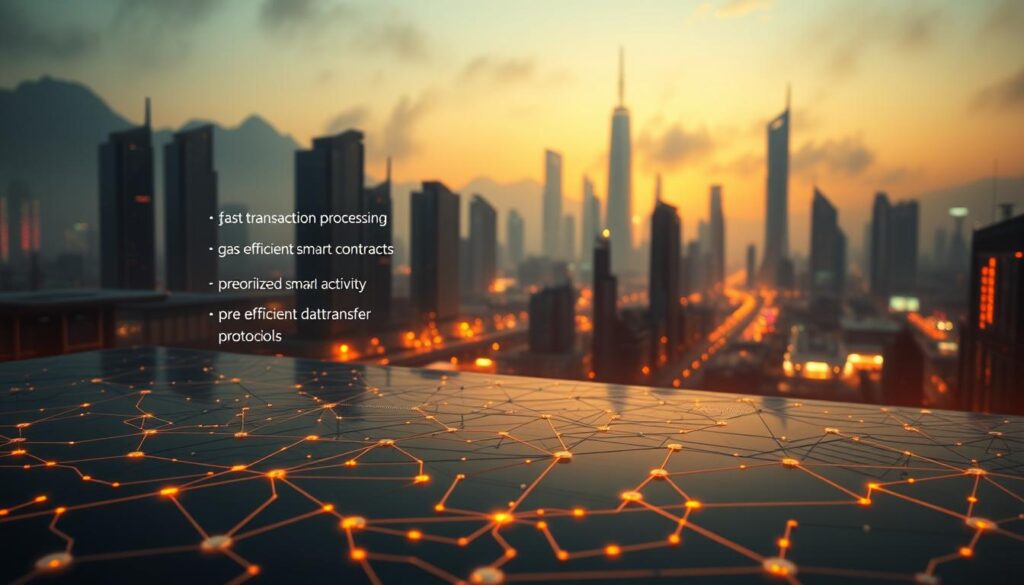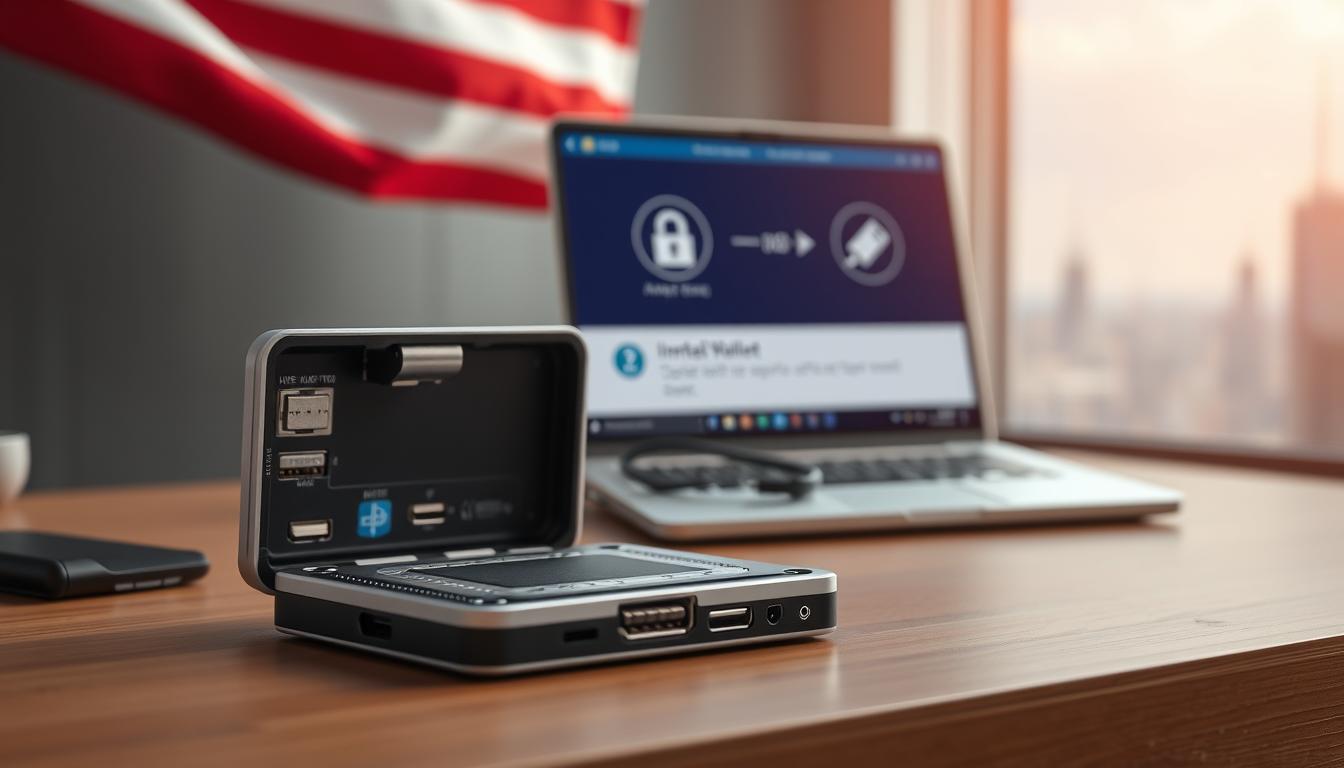Now Reading: Blockchain Transaction Fees: A Step-by-Step Guide
- 01
Blockchain Transaction Fees: A Step-by-Step Guide
Blockchain Transaction Fees: A Step-by-Step Guide

Blockchain transaction fees are a key part of using cryptocurrencies like Bitcoin or Ethereum. These fees make sure transactions are safe and fast. But, many people find them hard to understand.
Learning about blockchain transaction fees can help you save money and have a better crypto experience. This guide will explain why fees exist, how they’re calculated, and how to manage them well.
This guide covers everything from fee structures on major networks to tools for optimization. Whether you’re sending crypto or building apps, knowing about blockchain transaction fees is crucial. It helps avoid delays and spending too much. Let’s look at how these fees affect your digital transactions and how to handle them confidently.
Key Takeaways
- Blockchain transaction fees fund network security and speed.
- Fees differ across networks like Bitcoin and Ethereum.
- Overpaying or underpaying can lead to delays or higher costs.
- Tools and strategies exist to minimize fees without sacrificing speed.
- This guide provides actionable steps to manage fees across all networks.
What Are Blockchain Transaction Fees?
Blockchain transaction fees are the costs for sending data on decentralized networks. They ensure transactions are processed well and keep the network stable. Understanding transaction costs is key to using blockchain technology.
The Purpose of Transaction Fees in Blockchain Networks
Transaction fees in blockchain networks have three main roles. They prevent spam by charging for it. They also let users pay for faster processing. And, they help keep the network secure by paying miners and validators.
How Fees Incentivize Miners and Validators
Miners and validators get paid for checking transactions. On Ethereum, they get gas fees for smart contracts. Bitcoin miners get fees and block rewards. Without these, networks might stop working and lose security.
Fee Components in Different Blockchain Systems
- Bitcoin: Fees depend on transaction size (measured in satoshis per byte).
- Ethereum: Gas fees combine gas price × gas limit, varying with network demand.
- Solana: Uses a dynamic fee model based on recent block space usage.
These differences show why it’s important to understanding transaction costs for each platform before sending funds.
The Fundamentals of Blockchain Transaction Costs
Cryptocurrency transaction costs are key to blockchain economics. They help miners or validators choose which transactions to process first. It’s like cars racing for space on a busy road, with users bidding for a spot in the block.
Think of it like a toll road where drivers pay to use lanes. Blockchain networks work the same way. Transactions with higher fees get processed first. This system keeps the network safe by rewarding those who keep it running.
As more people use cryptocurrencies, costs go up. This is because there’s more competition for space in blocks. During big crypto booms, like in 2021, costs can skyrocket.
- Scarcity: Limited block sizes create competition for network space.
- Security Incentive: Fees reward nodes securing the network.
- Market Dynamics: Fees adjust automatically based on supply and demand.
These costs are not random. They follow the rules of real-world economics. Like cloud storage or electricity, blockchain’s fees balance efficiency and safety. Knowing this helps us understand why fees change and how networks grow.
How Blockchain Transaction Fees Work
Blockchain network fees use a system where users bid for space in blocks. The highest bids get priority, making fees dynamic and fair. This way, miners focus on the most valuable transactions first, keeping the network running smoothly.
Fee Markets and Bidding Systems
Users set fees based on demand. When demand is high, fees go up. Fee markets work like stock exchanges, with higher bids getting faster confirmation. Miners choose transactions that offer the best value, not just the highest fee.
Fee Prioritization Mechanisms
- Miners sort transactions by fee per data unit (e.g., satoshis/byte).
- Urgent transfers often pay premium rates to bypass delays.
- Complex smart contracts may require higher fees due to computational demands.
Mempool Dynamics and Transaction Processing
Transactions wait in the mempool until miners include them. During busy times, low-fee transactions may wait for hours. For example, in Bitcoin’s 2021 bull run, some transactions took days to confirm.
Understanding network load patterns helps reduce costs. Transactions go through three stages: submission, validation, and finalization. Fees affect the speed at each stage.
Key Factors That Influence Blockchain Transaction Fees
Blockchain transaction fees change due to several factors. Understanding transaction costs means looking at four key areas: network load, transaction complexity, market activity, and urgency. These factors affect how much users pay for transfers.
Network congestion can raise fees when it’s busy. In May 2021, Ethereum fees jumped to $65 during NFT sales. Thousands of users vying for space pushed fees up. Miners then focus on transactions that pay more.
Transaction size is important. Sending ETH with complex contracts or NFT bundles costs more. A simple Bitcoin transfer is cheap, but a complex DeFi trade can cost $20+. Each byte adds to the fee.
Market demand greatly affects fees. In 2020, Bitcoin’s halving led to a 300% fee increase as traders moved assets quickly. Crypto price rises, like in 2021, also increase fees, especially during DeFi summer.
Time-sensitivity impacts pricing. In 2023, users paying $50+ for Bitcoin transfers chose speed over saving. Tools like Etherscan’s gas tracker help balance cost and speed.
Keeping an eye on these factors can help users save money. By monitoring network activity and adjusting when to send transactions, costs can be lowered without sacrificing security or speed.
Understanding Gas Fees in Ethereum Transactions
Ethereum transactions need gas fees to work on its network. These fees help miners do their job and keep the network safe. Transaction fee optimization is key for users who want to save money and speed up transactions.
- Gas Price (gwei): This is how much each step costs.
- Gas Limit: It’s the max amount a transaction can spend.
- Base Fee: This fee changes with how busy the network is.
- Priority Fee: A small tip to miners for quick service.
- Max Fee: This is the total fee, combining base and priority fees.
The London Hard Fork added EIP-1559 in 2021. This update made base fees change automatically and started burning fees, reducing ETH supply.
Simple actions like sending ETH cost less gas than complex smart contracts. For example, setting up a DeFi protocol takes more steps than sending money, which raises gas costs. Users can save by using tools like Etherscan’s fee estimator or sending during quiet times.
To optimize transaction fees, set realistic max fees and watch the network. Don’t pay too much by making sure fees match the urgency of your transaction. Knowing these details helps users manage Ethereum’s fees without spending too much.
Bitcoin Transaction Fees Explained
Bitcoin’s blockchain fee calculation is unique. It focuses on data size, not how hard it is to process. Fees go up when the network gets busy. Knowing this helps users save money and avoid delays.

Satoshis per Byte Calculation
Bitcoin fees are based on how big your transaction is. Bigger or more complex transactions cost more. Segregated Witness (SegWit) helps by making data use more efficient.
A simple transaction might cost 50–100 satoshis/byte. But during busy times, it can go up to 500+ satoshis/byte. To save money, users can group transactions or use SegWit addresses. This makes blockchain fee calculation more efficient.
Bitcoin Fee Estimation Tools
- Mempool.space: Shows real-time fee rates and how fast transactions are confirmed.
- Bitcoin Core’s Built-in Estimator: Gives fee suggestions based on network load.
- Third-party wallets: Like Electrum or BlueWallet, offer live fee data for quick calculations.
Historical Fee Trends in Bitcoin
Bitcoin’s fee history shows interesting patterns. In 2017, fees soared to 50 USD+ per transaction. After halvings, fees can be unpredictable. But in 2020, the Lightning Network helped lower fees.
Step-by-Step Guide to Calculating Blockchain Transaction Fees
Learning blockchain fee calculation begins with knowing network tools and metrics. For Bitcoin, here’s how to do it:
- Check transaction data size in bytes via wallets like Bitcoin Core or Electrum.
- View current mempool congestion at mempool.space to estimate confirmation times.
- Select desired confirmation speed (1 hour vs. 24 hours).
- Multiply transaction size (bytes) by the satoshi-per-byte rate from fee estimation tools.
For Ethereum, follow these steps:
- Base Fee: Check current network’s base fee on Etherscan.io.
- Priority Fee: Set gas tip (gwei) based on network activity.
- Gas Limit: Use MetaMask’s built-in estimator for transaction complexity.
- Multiply all three values: (Base Fee + Priority Fee) × Gas Limit = total fee.
Always check fee settings before sending transactions. Wallets like Trust Wallet show real-time fee sliders. Watch fee trends at DeBank to find low-fee times. Adjusting transaction size or timing can save up to 50% during low-traffic times.
Start with testnet transactions to avoid overpaying. Most wallets now estimate fees automatically. But, manual adjustments are key during busy times.
Common Mistakes When Paying Blockchain Transaction Fees
Many users unknowingly waste funds or face delays due to fee missteps. Avoid these errors to streamline your crypto experience and focus on lowering blockchain transaction costs.
Overpaying Due to Urgency
Panic-driven fee hikes often backfire. During market spikes, users might set fees 300% higher than needed to speed up confirmations. Tools like Etherscan’s Gas Tracker or Bitcoin’s Blockchair show real-time demand, helping you avoid overpaying. For instance, during Ethereum’s London upgrade, users who waited 30 minutes saved 50% by monitoring fee trends.
Underpaying and Transaction Delays
Setting fees too low risks stuck transactions. In Bitcoin, underpaying can leave payments pending for days. Use Replace-By-Fee (RBF) to bump up fees on stuck Bitcoin transactions. Ethereum’s EIP-1559 reduced this risk by introducing base fees, but manual adjustments still matter during congestion.
Ignoring Fee Estimation Tools
Guessing fees leads to errors. Wallets like MetaMask include built-in gas calculators, yet many users override these. For example, ignoring Bitcoin Core’s fee slider caused $2M in stuck funds in 2022. Always verify with official tools before sending.
Strategies for Reducing Your Blockchain Transaction Fees
Lowering transaction costs doesn’t mean you have to give up security or reliability. Making a few simple changes can save you a lot of money. Try sending transactions when the network is less busy. This could be on weekends or late at night, when there are fewer people trying to send money.

- Batch Transactions: Send several payments together. Bitcoin users with SegWit addresses can save up to 20% by doing this.
- Optimize Transaction Sizes: Make your data loads simpler. Ethereum smart contracts can save on gas costs by being less complex or by breaking tasks into fewer steps.
- Use Layer 2 Solutions: Platforms like the Lightning Network for Bitcoin or Polygon for Ethereum can lower fees. They do this by moving transactions off the main layer.
- Monitor Fee Trends: Use tools like ETHGasStation or Blockchair to watch fee changes in real-time. This helps you send money when fees are lower.
Keep in mind, lower fees might mean your transactions take longer. If you need something sent quickly, choose speed over cost. But if you can wait, plan your transactions to save money. By using these strategies, you can cut costs by up to 50% without losing any important features.
Transaction Fee Optimization Techniques for Different Networks
Mastering transaction fee optimization needs strategies for each blockchain. Ethereum, Bitcoin, and altcoins each need unique ways to cut costs without slowing down.
Ethereum Fee Optimization
For Ethereum users, gas fee reduction begins with timing. Watch gas price trends on ETH Gas Station to send during off-peak hours. Use Flashbots to dodge miner extractable value (MEV) risks.
Adjust gas limits carefully—too high wastes money, too low can fail. ERC-20 tokens need approval first, so batch them to save on fees.
Bitcoin Fee Management
Bitcoin’s fees are about UTXO management. Merge small outputs during low-fee times with Bitcoin Core. Enable Replace-By-Fee (RBF) for urgent transactions.
Use Blockchair to find the best times for big transfers.
Optimizing Fees on Altcoin Networks
Altcoins differ a lot. Solana has fixed fees, while Avalanche lets you bid for priority. Cardano users can compress metadata to save.
Check wallet settings in Trust Wallet or Phantom for fee options. Use CoinGecko’s tool to compare fees before sending.
Follow these steps to save money without waiting. Focus on tools and timing for each network to cut costs.
Layer 2 Solutions and Their Impact on Transaction Costs
Layer 2 technologies help reduce blockchain fees by moving transactions off the mainnet. They process data off-chain while keeping the main layer secure. This cuts costs by 90% or more.
Understanding Rollups and Sidechains
Rollups combine many transactions into one mainnet post. Optimistic rollups check if transactions are valid later. Zero-knowledge rollups prove it upfront using cryptography. Sidechains are separate blockchains with their own rules, reducing fees by 95% for everyday payments.
Popular Layer 2 Options for Fee Reduction
- Optimism: Ethereum L2 with 0.01% of base layer fees
- Arbitrum One: Smart contract platform with $0.01 average fees vs Ethereum’s $30+
- Lightning Network: Bitcoin’s micropayment channels enabling $0.0001 transactions
- Polygon zkEVM: Zero-knowledge proofs cut fees by 99% for DeFi interactions
Trade-offs Between Security and Cost
Users choose lower costs over full decentralization. Rollups have single points of failure. Sidechains might lose control over funds. Always check bridge security before moving assets.
Use Layer 2 for non-urgent payments or token trades. Mainnet is best for high-value, urgent transfers. Always check gas tracking tools like Arbiscan or PolygonScan before bridging assets.
When to Pay Higher Blockchain Transaction Fees
It’s important to find ways to lower blockchain transaction costs. But sometimes, you need to pay more for your transactions to go through. Here’s when you might need to do that:

- Time-sensitive opportunities: Missing out on NFT drops or token sales can cost far more than a higher fee. When deadlines loom, speed matters.
- High-value transfers: Large crypto deals or urgent trades may justify premium fees to confirm within minutes, avoiding price swings.
- Congestion peaks: During busy periods, miners prioritize higher-fee transactions. Paying more ensures your transaction isn’t stuck in a mempool for hours.
For instance, a trader underpaying during Bitcoin’s halving event might miss out on gains worth thousands—far exceeding the fee difference. A decision framework: weigh the transaction’s urgency, value, and network state. Tools like Morpher’s fee guides help gauge optimal fee levels. Prioritize paying more only when delays risk bigger losses than the fee itself.
Tools and Resources for Monitoring Fee Trends
Managing blockchain transaction fees needs good tools to track costs and adjust strategies. These tools help understanding transaction costs by giving real-time data and useful insights.
Fee Trackers and Estimation Services
Platforms like ETH Gas Station for Ethereum and mempool.space for Bitcoin show live fee charts and past trends. Block explorers like Etherscan have fee analytics to compare current rates. Users can see gas price changes and network congestion to time transactions well.
Mobile Apps for Fee Management
- MyCrypto app sends gas price alerts for Ethereum networks.
- Trust Wallet shows real-time fee estimates during transfers.
- DeFi Pulse tracks altcoin fees across multiple chains.
These apps let users set price alerts for automatic notifications, cutting down on manual checks.
Building Your Fee Strategy Toolkit
Combine tools to make a system that works for you:
- Use fee trackers to watch trends over 24 hours.
- Set mobile app alerts for fee drops using specific price thresholds.
- Review historical data weekly to adjust long-term strategies.
Keeping your toolkit up to date ensures you meet network demands. This way, you avoid overpaying and keep transactions fast.
How Different Wallet Types Handle Transaction Fees
Cryptocurrency transaction costs change a lot based on the wallet type. Hardware wallets like Ledger and Trezor let advanced users control fees. They can adjust values before sending money. These devices show real-time fee estimates but need technical knowledge to use well.
Mobile wallets, such as Trust Wallet or BRD, make fee management easy with auto-calculated defaults. But, they don’t let users change settings manually. Desktop wallets, like Exodus or Electrum, offer basic fee sliders but don’t have the advanced options of hardware wallets. Browser extensions, like MetaMask, have clear fee sliders and show EIP-1559 visualizations for Ethereum transactions.
- Custodial exchange wallets (e.g., Coinbase Wallet) often hide fee details. They auto-select speeds based on network conditions. Users have little control here.
- Non-custodial wallets like Atomic Wallet let users choose between “fast,” “standard,” or “economic” modes. But, fee transparency varies between platforms.
- Specialized wallets such as Argent (Ethereum) auto-optimize fees using algorithms. They don’t need user input.
Advanced users who want to control fees should use hardware or desktop wallets. Beginners might like mobile apps that simplify things but should watch cryptocurrency transaction costs during busy times. Always check wallet settings for fee estimation modes. Some default to speed over cost efficiency. Keeping wallets updated ensures access to new features like fee bumping or replace-by-fee options, which can lower costs during congestion.
Future Developments in Blockchain Fee Structures
Blockchain network fees are changing as developers work on making things faster and cheaper. New designs and economic models are being tested. Here’s what’s coming:

Protocol Upgrades Lowering Costs
Ethereum is planning to split data into smaller parts to reduce congestion and lower costs. Bitcoin’s Taproot upgrade has already made complex transactions cheaper. Solana is exploring new ways to cut overhead charges.
New Fee Market Models
Researchers are looking into new fee models, like subscription tiers or dynamic caps. Some networks might have fees that change based on usage. This could reward users for using the network less.
Technical Breakthroughs
- Layer 2 rollups can bundle thousands of transactions into one block, cutting costs by 90%.
- Zero-knowledge proofs allow private transactions without extra fees.
- Next-gen protocols like StarkEx need less data storage, further reducing fees.
Users will need to adapt as these changes happen. Keeping up with updates and trying new tools will help manage costs.
Mastering Blockchain Fees to Optimize Your Crypto Experience
Understanding blockchain transaction fees is crucial for using cryptocurrency wisely. By watching network congestion and using fee tools, you can save money. It’s important to consider timing and transaction size, especially with Ethereum’s gas fees or Bitcoin’s satoshi-per-byte model.
Optimizing fees means using Layer 2 solutions like Ethereum’s rollups or Bitcoin’s Lightning Network. Tools like Etherscan and Bitcoin Core give real-time data to avoid overpaying. Off-chain methods are cheaper for regular transfers than on-chain transactions alone.
Keeping up with protocol upgrades, like Ethereum’s move to proof-of-stake, helps users adjust to fee changes. Balancing speed and cost is key. For example, prioritize speed for urgent trades or delay non-urgent ones to save money. Proactive fee management makes crypto use easier.
Knowing about blockchain transaction fees helps users save and be more efficient. As networks grow, using best practices now prepares you for the future. With smart fee strategies, every transaction becomes a better financial choice.
FAQ
What are blockchain transaction fees?
Blockchain transaction fees are charges for processing transactions on a blockchain network. They help miners and validators do their work. They also keep the network secure and prevent spam.
How are cryptocurrency transaction costs determined?
Costs are influenced by network congestion, transaction size, and complexity. Market demand also plays a role. Each blockchain has its own fee structure, leading to price changes.
What is gas and how does it relate to transaction fees on Ethereum?
Gas is the computational work needed to validate a transaction on Ethereum. Fees are based on gas used and gas price. This affects the total cost of a transaction.
How can I lower my blockchain transaction costs?
To lower costs, time transactions during off-peak hours. Batch multiple transactions together. Optimize gas usage on Ethereum. Use SegWit for Bitcoin. Fee estimation tools can also help.
What tools are available to monitor blockchain transaction fees?
ETH Gas Station and mempool.space provide real-time fee data. Mobile apps alert users when fees drop. This helps with cost-effective timing.
Why do transaction fees fluctuate significantly during peak times?
Fees rise during peak times due to high demand. When demand outstrips block space, users must bid higher fees. This ensures quicker confirmation.
What is the mempool, and how does it affect transaction fees?
The mempool is a collection of pending transactions. Its congestion levels affect fees. Users compete to get their transactions included in blocks.
How can mistakes in transaction fee payments impact my experience?
Mistakes like overpaying or underpaying can cause delays. Fee estimation tools help avoid these issues. They ensure timely and cost-effective transactions.
How can Layer 2 solutions help reduce blockchain transaction fees?
Layer 2 solutions, like rollups and sidechains, process transactions off the main blockchain. This reduces fees by bundling transactions. It helps alleviate congestion and lower costs.
What strategies can I implement to optimize my transaction fees?
To optimize fees, time transactions during low-demand periods. Use fee estimation tools. Consolidate transactions. Employ blockchain-specific techniques, like flashbots for Ethereum or UTXO management for Bitcoin.













